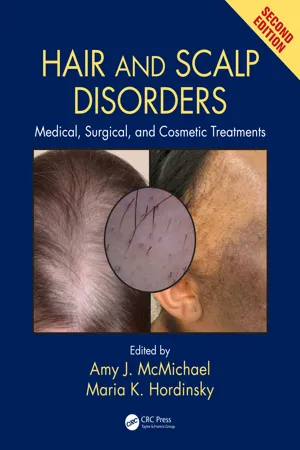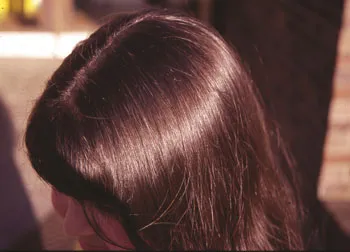
eBook - ePub
Hair and Scalp Disorders
Medical, Surgical, and Cosmetic Treatments, Second Edition
- 309 pages
- English
- ePUB (mobile friendly)
- Available on iOS & Android
eBook - ePub
Hair and Scalp Disorders
Medical, Surgical, and Cosmetic Treatments, Second Edition
About this book
A succinct and comprehensive guide examining the treatment of hair and scalp disorders, with a special emphasis on how hair type, morphology, and ethnicity can impact on hair disease and treatment. This updated and revised second edition builds on a successful first edition with additional chapters on dermoscopy, on how technology can best be integrated into clinical practice, and on aging hair.
Frequently asked questions
Yes, you can cancel anytime from the Subscription tab in your account settings on the Perlego website. Your subscription will stay active until the end of your current billing period. Learn how to cancel your subscription.
At the moment all of our mobile-responsive ePub books are available to download via the app. Most of our PDFs are also available to download and we're working on making the final remaining ones downloadable now. Learn more here.
Perlego offers two plans: Essential and Complete
- Essential is ideal for learners and professionals who enjoy exploring a wide range of subjects. Access the Essential Library with 800,000+ trusted titles and best-sellers across business, personal growth, and the humanities. Includes unlimited reading time and Standard Read Aloud voice.
- Complete: Perfect for advanced learners and researchers needing full, unrestricted access. Unlock 1.4M+ books across hundreds of subjects, including academic and specialized titles. The Complete Plan also includes advanced features like Premium Read Aloud and Research Assistant.
We are an online textbook subscription service, where you can get access to an entire online library for less than the price of a single book per month. With over 1 million books across 1000+ topics, we’ve got you covered! Learn more here.
Look out for the read-aloud symbol on your next book to see if you can listen to it. The read-aloud tool reads text aloud for you, highlighting the text as it is being read. You can pause it, speed it up and slow it down. Learn more here.
Yes! You can use the Perlego app on both iOS or Android devices to read anytime, anywhere — even offline. Perfect for commutes or when you’re on the go.
Please note we cannot support devices running on iOS 13 and Android 7 or earlier. Learn more about using the app.
Please note we cannot support devices running on iOS 13 and Android 7 or earlier. Learn more about using the app.
Yes, you can access Hair and Scalp Disorders by Amy J. McMichael, Maria K. Hordinsky, Amy J. McMichael,Maria K. Hordinsky in PDF and/or ePUB format, as well as other popular books in Medicine & Medical Theory, Practice & Reference. We have over one million books available in our catalogue for you to explore.
Information
1Human Hair
John Gray
Introduction
Hair first arrived on the evolutionary scene some 310 million years ago on reptilian-like animals, preceded and survived the rise and extinction of the dinosaurs, and emerged as the dominant skin appendage of the class of mammals. As members of this class, modern humans have “inherited” skin which, although bearing several million hair follicles covering 95% of the body, have largely confined growing hair to the scalp.
Human Scalp Hair
Unlike our primate cousins, we, the fifth and “naked” ape, do not possess an all-encompassing, thick, and pigmented pelage. Once the body-wide intrauterine lanugo hairs are shed, visible follicular activity is confined to the scalp, with secondary sexual sites a poor second even after puberty.
Since the human head bears some 100,000–150,000 hair follicles, an individual adult with 30 months continuous, unstyled growth at 0.9 cm per month will carry some 30 kilometers of hair. This is a significant investment in protein and energy consumption.
Function of Human Hair
The function of human hair is, curiously, unresolved. Hypotheses vary: Is it a relic of an aquatic phase of human development where a pelage would be an impairment, or an integral adaptation for thermoregulation and ultraviolet protection? Is it a mere adornment, or the result of Fisherian runaway sexual selection? All of these theories can be disproved, not least by the tendency for humans of both sexes to bald. Sociological research has suggested that hair is often interpreted as a marker of age, health, nutrition, and fecundity. In its styled form, it is employed in all societies to express social status or cultural affiliation. Hair in most cultures is at its zenith on the wedding day. By contrast, sociological studies have revealed the full impact of so-called “bad hair days,” where subjective and objective negative assessment of hair may reduce self-esteem.
Modern hair care involving the use of many products is an (almost) ubiquitous human habit in the twenty-first century. These products are increasingly designed to repair and protect hair from environmental and self-inflicted damage while preparing it for styling.
Structure of Hair
Many other publications describe in detail the human hair follicle, its unparalleled metabolic activities, and its failings. It is the end-product of this activity—the human hair shaft—which we discuss in this chapter.
There are three essential types of hair in humans, which are dependent to some extent on the size of the follicle.
Lanugo Hair
Lanugo hair is fine and non-medullated hair which appears on the fetus, and with rare exceptions is shed prior to or immediately after birth (Figure 1.1).

Figure 1.1Lanugo hair seen on the face of a newborn. (From Gray J, The World of Hair, Macmillan, 1977, with permission.)
Vellus Hair
Vellus hair is fine, short, and non- or lightly pigmented (less than 40 microns in diameter), and is the most numerous of human hairs. It can be seen from the neonatal period onward covering all surfaces other than the palms of the hands and soles of the feet. At puberty, some vellus hairs enlarge to become terminal hairs, and develop sebaceous glands. Vellus hairs occur on the scalp but are far less numerous than terminal hairs.
In male and female pattern hair loss, terminal hairs miniaturize and return to the size of vellus hairs. This can be reversed with treatment.
Terminal Hair
Terminal hair is thick, long, and pigmented. It is some 50 to 150 microns thick. Terminal hairs are the dominant hairs on the scalp, eyebrows, lashes, axillae, and genital areas. In men, terminal hairs are variably found on the trunk and legs. There is great regional difference in terminal body hairs.
Cross-section of the terminal hair shaft reveals three major components:
- Cuticle—the outer protective layer
- Cortex—the core of the hair
- Medulla—a central soft protein core which is more common in thicker hair, and particularly so in white hairs
The main constituents of these structures are sulfur-rich proteins, lipids, water, melanin, and trace elements.
Cuticle
The cuticle is composed of specialized keratins and consists of six to eight layers of flattened overlapping cells with their free edges directed upward to the tip of the hair shaft. There are several layers to each cell. The innermost endocuticle is covered by the exocuticle, which lies closer to the external surface and is comprised of three parts: the b-layer, the a-layer, and the epicuticle. The b-layer and the a-layer are largely proteinaceous, while the epicuticle is a hydrophobic lipid layer of 18-methyleicosanoic acid (a main component of the outer layer of the epicuticle of human hair that endows hydrophobicity to the outer hair surface) attached via a covalent chemical bond to the surface of the fiber. This is commonly known as the f-layer.
The f-layer is of critical importance to hair health. The cuticle’s complex structure (Figure 1.2) allows it to slide as the hair swells, and the f-layer imbues a considerable degree of hydrophobicity. It is critical in protecting the hair and rendering it resistant to the influx and outflow of moisture.

Figure 1.2Overlapping scales of the cuticle. (From Gray J, The World of Hair, Macmillan, 1977, with permission.)
The undamaged cuticle has a smooth appearance and feel. It is primarily responsible for the luster and texture of the hair (Figure 1.3).

Figure 1.3Reflection from the intact cuticles of well-aligned hair is largely responsible for hair shine. (From Gray J, The World of Hair, Macmillan, 1977, with permission.)
The cuticle may be damaged by any of four major “insults”—envir...
Table of contents
- Cover
- Half Title Page
- Title Page
- Copyright Page
- Dedication
- Contents
- Preface
- Editors
- Contributors
- Chapter 1 Human Hair
- Chapter 2 Evaluation
- Chapter 3 Dermoscopy of Hair and Scalp Disorders (Trichoscopy)
- Chapter 4 Photographic Imaging of Hair Loss
- Chapter 5 Hair Follicle Anatomy in Human Scalp Biopsies
- Chapter 6 Nonmedicated Grooming Products and Beauty Treatments
- Chapter 7 Practical Case Scenarios: How to Utilize Products
- Chapter 8 Dandruff and Seborrheic DermatitisUse of Medicated Shampoos
- Chapter 9 Alopecia Areata
- Chapter 10 Androgenetic Alopecia
- Chapter 11 Telogen Effluvium
- Chapter 12 Cicatricial Alopecia
- Chapter 13 Structural Hair Abnormalities
- Chapter 14 Scalp Prostheses: Wigs, Hairpieces, Extensions, and Scalp-Covering Cosmetics
- Chapter 15 Hair Transplantation for the Dermatologist
- Chapter 16 Alternative Treatments for Hair Loss
- Chapter 17 Hirsutism and Hypertrichosis
- Chapter 18 Light-Assisted Hair Removal and Hair Growth
- Chapter 19 Allergic Contact Dermatitis
- Chapter 20 Psychodermatoses Involving Hair
- Chapter 21 Scalp Infections and Infestations
- Chapter 22 Sources of Alopecia Information for Physicians and Patients
- Chapter 23 Approach to the Alopecia Patient
- Chapter 24 Hair Aging and Anti-Aging Strategies
- Index